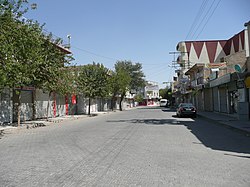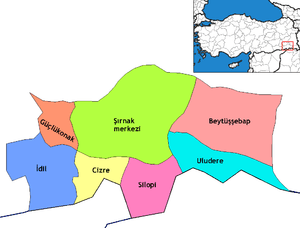İdil
İdil (Syriac: ܐܙܟ, romanized: Azakh,[3][nb 1] or Beth Zabday,[6] Kurdish: Hezex,[7] Arabic: آزخ, romanized: Azekh)[8] is a city and district in Şırnak Province in southeastern Turkey. It is located in the historical region of Tur Abdin.
İdil | |
|---|---|
 | |
 İdil | |
| Coordinates: 37°20′30″N 41°53′30″E | |
| Country | |
| Province | Şırnak |
| Government | |
| • Mayor | Songül Erdem (HDP) |
| • Kaymakam | Zafer Sağ |
| Area | |
| • District | 1,266.10 km2 (488.84 sq mi) |
| Population (2019)[2] | |
| • Urban | 29,097 |
| • District | 76,895 |
| • District density | 61/km2 (160/sq mi) |
| Post code | 733xx |
| Website | www.idil.bel.tr |
In the city, there is a Syriac Orthodox Church of the Mother of God (Arabic: كنيسة العذراء,[8] Turkish: Meryem Ana Kilisesi).[9]
History

Azakh (today called İdil) is identified as the town of Ashikhu,[10] or Asiḫu, which is earliest attested in an administrative note from the governor's archive at Tell Halaf, during the reign of Adad-nirari III, King of Assyria, in the late 9th and early 8th century BC.[11] Azakh was later conflated with the neighbouring city of Bezabde, and led to its alternative Syriac name Beth Zabday.[12]
Ottoman Empire
Mohammed Paşa, Emir of Rowanduz, took advantage of the disruption caused to the Ottoman Empire by the Egyptian invasion of Syria in 1831–1832 to expand his realm, and besieged Azakh in 1834.[13][14] The emir surrendered, however, upon the arrival of a large Ottoman army under the leadership of Reşid Mehmed Pasha.[13] The village was attacked again later by Bedir Khan Beg, Emir of Bohtan, in 1847,[15] resulting in the death of Cyril George, Syriac Orthodox Archbishop of Azakh,[16] a priest, and eight congregants.[17]
At the beginning of the 20th century, the village had a population of 1000, and was inhabited by Arabic-speaking Syriac Orthodox and Syriac Catholic Assyrians,[18][19] some of whom emigrated to Brazil in 1914.[20] Amidst the Assyrian genocide, in July 1915,[19] refugees from the villages of Esfes, Kefshenne, Kufakh, Babqqa, and Khaddel fled to Azakh.[21] The village was subsequently attacked by Kurdish tribesmen from mid-August until their withdrawal on 9 September.[19] An expeditionary force of approximately 8000 Ottoman soldiers and Kurdish auxiliaries,[22] led jointly by Max Erwin von Scheubner-Richter and Ömer Naci, was diverted from its original task to conduct anti-Russian operations in Iran to besiege Azakh,[23] and arrived in late October.[19] Scheubner-Richter refused to involve Germans in the siege, and the first attack began on 7 November.[19] After subsequent attacks, and an Assyrian counter-attack on 14 November, the Turkish army retreated on 21 November.[19]
Republic of Turkey
The village became the seat of a bucak (subdistrict) of Cizre in 1924.[24] In the following year, a number of villagers emigrated to Brazil,[20] at which time 100 Assyrians were deported from Azakh.[25] In the aftermath of the failure of the Kurdish Sheikh Said Rebellion, the Turkish government enacted oppressive measures, thus in 1926 the inhabitants of Azakh were accused of complicity in the rebellion, and of possession of arms received from the British government.[26] The Turkish authorities alleged that the village's men had served in the British Iraq Levies on the basis of the discovery of British rifles and permits to carry arms in English and Arabic in Azakh.[26] The population was thus disarmed after the arrival of 1500 Turkish soldiers, and 257 or 357 men from Azakh and neighbouring villages, including notables and three priests, were accused of treason, arrested, and imprisoned at Cizre.[26][27] The Assyrians of Azakh were deemed unsuitable for Turkification by the Turkish government, and as a result aimed to exterminate those who had survived the genocide, whereby those who had been arrested were beaten and denied food whilst imprisoned.[27] They were later transferred to Midyat, where most were released in August 1926, whilst notables remained imprisoned, who were transferred to Harpoot until eventually released after five more months.[27]
Assyrians from Azakh emigrated to Ain Duwar and Al-Malikiyah in northeastern Syria in the early 1930s after the construction of French military bases.[28] The village was elevated to district in 1937, upon which it was officially renamed İdil.[24] The village was inhabited by 3500 Assyrians in 1964.[29] As a result of the Cypriot crisis of 1963-1964, Assyrians of Azakh were the victim of anti-Christian riots.[30] The village was exclusively populated by Christian Assyrians until the mid-1970s;[31] this was in part due to the prohibition of sale of property to Muslim Kurds by Mayor Şükrü Tutuş.[32] Efforts to encroach on the Assyrian population resulted in the construction of social housing for Kurds in the village , who consequently amounted to 10% of the population,[32] and the election of Abdurrahman Abay, chief of the Kurdish Kecan tribe, as mayor in 1979 with the aid of the Turkish authorities, including the military commander, judge, and district governor.[33] Abay alleged that he received congratulations via telegram from Anwar Sadat, President of Egypt, for the "Muslim conquest of Idil".[33] This led the Assyrian population to decline in the 1970s and 1980s.[29]
After their forced eviction by the Turkish army on 20 November 1993, a number of Assyrian refugees from Hassana fled to Azakh.[34] On 9 January 1994, Melke Tok, priest of Miden, was abducted whilst en route from İdil to Bsorino.[35] The priest was later released after negotiations,[36] and attested that, whilst in captivity, he was buried alive and pressured into converting to Islam.[37] The murder of former mayor Şükrü Tutuş on 17 June 1994 led the remaining Christian population of several hundred people to seek asylum in Western Europe, and was followed by the Kurdish repopulation of the village.[33] Assyrians later returned, but by 2015 only 50 Assyrians inhabited the city.[29]
The eruption of violence in early 2016 led all but two Assyrians to flee İdil,[29] as well as an estimated three thousand people, and a curfew was imposed on 16 February.[38] The Turkish army began operations in the city on 18 February and claimed to have killed at least 47 PKK militants by 25 February.[39] The curfew was partially lifted on 31 March and the refugees returned to İdil,[40] including at least four Assyrian families.[29] In late July 2019, Assyrian properties in the district were struck by suspected arson attacks.[41]
Notable people
- Jacques Behnan Hindo (b. 1941), Syriac Catholic Archbishop of Al-Hasakah-Nisibis.[42]
Mayors
| Election | Mayor | Party |
|---|---|---|
| 2019 | Songül Erdem | HDP |
| 2014 | Mehmet Muhdi Arslan | BDP |
| 2009 | Resul Sadak | DTP |
| 2004 | Resul Sadak | SHP |
| 1994 | Murat Dalmış | DYP |
| 1979 | Abdurrahman Abay | ANAP |
| 1966 | Şükrü Tutuş | ANAP |
Mayor Mehmet Muhdi Arslan was suspended on 20 September 2016 following his arrest in August on suspicion of aiding and abetting the PKK, and Kaymakam (district governor) Ersin Tepeli was appointed as trustee on the following day.[43]
References
Notes
Citations
- "Area of regions (including lakes), km²". Regional Statistics Database. Turkish Statistical Institute. 2002. Retrieved 5 March 2013.
- "İDİL NÜFUSU, ŞIRNAK". Türkiye Nüfusu (in Turkish). Retrieved 11 August 2020.
- Carlson, Thomas A. (14 January 2014). "Āzakh". The Syriac Gazetteer. Retrieved 11 August 2020.
- Sinclair (1989), p. 351.
- Jongerden & Verheij (2012), p. 327.
- Biner (2019), p. x.
- Avcıkıran (2009), p. 57.
- "السريان يشاركون في مؤتمر بازبدي (آزخ) الدولي في تركيا". Ishtar TV (in Arabic). Retrieved 18 December 2019.
- DelCogliano (2006), p. 341.
- Palmer (1990), p. 29.
- Radner (2006), pp. 296-297.
- Palmer (1990), p. 155.
- Jongerden & Verheij (2012), pp. 253-254.
- Barsoum (2003), p. 157.
- Abdalla (2018), p. 97.
- Barsoum (2008), p. 59.
- Jongerden & Verheij (2012), p. 255.
- Bardakci et al. (2017), p. 169.
- "Azakh". Foundation for Conservation and Promotion of the Aramaic Cultural Heritage (in German). Retrieved 11 August 2020.
- Atto (2011), p. 163.
- Sato (2001), p. 54.
- DelCogliano (2006), p. 342.
- Dadrian (2002), p. 66.
- "İdil". Şırnak Valiliği (in Turkish). Retrieved 11 August 2020.
- Atto (2011), p. 98.
- Altuġ (2011), pp. 127-128.
- Sato (2001), pp. 62-63.
- Sato (2001), p. 64.
- Güsten (2016), p. 9.
- Güsten (2016), p. 8.
- Joseph (1984), p. 103.
- Susanne Güsten (22 January 2015). "Robert Tutus ist der letzte Christ im anatolischen Idil". Der Tagesspiegel (in German). Retrieved 28 December 2019.
- Susanne Güsten (4 April 2012). "Hopes to Revive the Christian Area of Turkey". New York Times. Retrieved 8 December 2019.
- Atto (2011), p. 139.
- "UA 03/94 - TURKEY: ABDUCTION / FEAR OF EXTRAJUDICIAL KILLING: MELKE TOK". Amnesty International. 10 January 1994. Retrieved 27 December 2019.
- Atto (2011), p. 133.
- Pacal, Jan (29 August 1996). "What happened to the Turkish Assyrians?". Assyrian International News Agency. Retrieved 27 December 2019.
- "Fresh curfew declared amid exodus from İdil". Hürriyet Daily News. 16 February 2016. Retrieved 27 December 2019.
- "Turkish army kills 47 PKK militants in İdil in week". Hürriyet Daily News. 25 February 2016. Retrieved 27 December 2019.
- "Thousands return to ruined İdil after 43-day curfew". Hürriyet Daily News. 31 March 2016. Retrieved 27 December 2019.
- "Fires on Assyrian land raise arson alarm". Ahval News. 6 August 2019. Retrieved 27 December 2019.
- "Archbishop Jacques Behnan Hindo". Catholic-Hierarchy. Retrieved 11 August 2020.
- "İdil Belediyesi'ne kayyum atandı". Sabah (in Turkish). 21 September 2016. Retrieved 28 December 2019.
Bibliography
- Abdalla, Michael (2018). "The term Seyfo in historical perspective". In Hannibal Travis (ed.). The Assyrian Genocide: Cultural and Political Legacies. Routledge. pp. 92–105.
- Altuġ, Seda (2011). Sectarianism in the Syrian Jazira: Community, land and violence in the memories of World War I and the French mandate (1915- 1939). Utrecht University. Retrieved 11 August 2020.
- Atto, Naures (2011). Hostages in the Homeland, Orphans in the Diaspora: Identity Discourses Among the Assyrian/Syriac Elites in the European Diaspora (PDF). Leiden University Press. Retrieved 27 December 2019.
- Avcıkıran, Adem (2009). Kürtçe Anamnez Anamneza bi Kurmancî (PDF) (in Turkish and Kurdish). Retrieved 17 December 2019.
- Bardakci, M.; Freyberg-Inan, A.; Giesel, C.; Leisse, O. (2017). Religious Minorities in Turkey: Alevi, Armenians, and Syriacs and the Struggle to Desecuritize Religious Freedom. Palgrave Macmillan UK. ISBN 978-1-137-27026-9. Retrieved 25 October 2019.CS1 maint: ref=harv (link)
- Barsoum, Ephrem (2003). The Scattered Pearls: A History of Syriac Literature and Sciences. Translated by Matti Moosa (2nd ed.). Gorgias Press. Retrieved 14 July 2020.
- Barsoum, Ephrem (2008). History of the Za‘faran Monastery. Translated by Matti Moosa. Gorgias Press.
- Biner, Zerrin Ozlem (2019). States of Dispossession: Violence and Precarious Coexistence in Southeast Turkey. University of Pennsylvania Press.
- Dadrian, Vahakn N. (2002). "The Armenian Question and the Wartime Fate of the Armenians as Documented by the Officials of the Ottoman Empire's World War I Allies: Germany and Austria-Hungary". International Journal of Middle East Studies. 34 (1): 59–85. doi:10.1017/S0020743802001034.
- DelCogliano, Mark (2006). "Syriac Monasticism in Tur Abdin: A Present-Day Account". Cistercian Studies Quarterly. 41 (3): 311–349.
- Güsten, Susanne (2016). A Farewell to Tur Abdin (PDF). Retrieved 27 December 2019.
- Jongerden, Joost; Verheij, Jelle (2012). Social Relations in Ottoman Diyarbekir, 1870-1915. Brill.
- Joseph, John (1984). Muslim-Christian Relations and Inter-Christian Rivalries in the Middle East: The Case of the Jacobites in an Age of Transition. SUNY Press.
- Palmer, Andrew (1990). Monk and Mason on the Tigris Frontier: The Early History of Tur Abdin. Cambridge University Press. Retrieved 15 July 2020.
- Radner, Karen (2006). "How to reach the Upper Tigris: The route through the Tur Abdin" (PDF). State Archives of Assyria Bulletin. 15: 273–305. Retrieved 11 August 2020.
- Sato, Noriko (2001). Memory and Social Identity among Syrian Orthodox Christians (PDF). Retrieved 27 December 2019.
- Sinclair, T.A. (1989). Eastern Turkey: An Architectural & Archaeological Survey, Volume III. Pindar Press. ISBN 9780907132349.